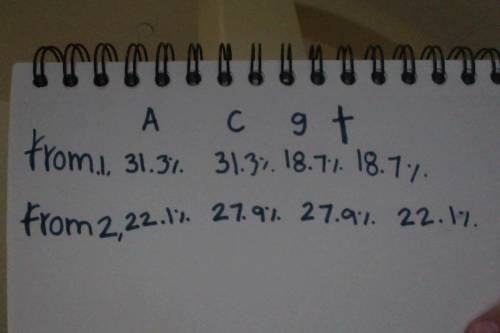
Biology, 13.01.2021 15:40 reyesmtz5414
Is the sequence of a dna strand is aagcca what are the bases on its complementary strand

Answers: 3


Another question on Biology

Biology, 21.06.2019 19:10
What have we learned from fossil evidence about evolution? a) it is an abrupt change. b)the process is observable. c) it takes place during one lifetime only. d)the most complex traits are always selected.
Answers: 2

Biology, 21.06.2019 23:00
Which best describes the digestive system of arthropods? a incomplete, two openings b complete, one opening c two-way, one opening d one-way, two openings
Answers: 3

Biology, 22.06.2019 03:00
Why do leaves change color in the fall? green pigments break down and no longer mask the color of chlorophyll. chlorophyll breaks down and no longer masks the colors of other pigments. red- and yellow-colored pigments grow and mask green-colored chlorophyll. green-colored chlorophyll breaks down and turns red and yellow.
Answers: 2

Biology, 22.06.2019 03:30
Rease is an enzyme used by plants to break down urea (a nitrogen-containing compound) into carbon dioxide and ammonia. urease urea > > > carbon dioxide and ammonia ammonia is broken down by plants into a nitrogen source plants need to grow. thus, plants could not use urea as a nitrogen source unless it was first converted to ammonia. in soybean plants there are two different kinds of urease, one produced in the seeds and the other produced in the leaves of the plant. three types of soybean plants were used in a set of experiments: normal soybeans and two mutant strains, one lacking the urease in the seeds only (strain 1) and one lacking urease in the leaves only (strain 2). experiment 1 separate areas in a field were planted with normal, strain 1, and strain 2 soybeans. all types of soybeans appeared to grow, flower, and produce seeds equally well. there were no externally detectable differences among the strains. experiment 2 small pieces of plant leaves of equal weight were obtained from each type of soybean plant and separately placed on media in culture dishes. tissue growing in this way will become an unorganized clump of cells referred to as callus. to provide a controlled nitrogen source, half the tissue samples of each type were placed on media containing urea, and the other half of the samples were placed on media containing ammonia. after 30 days, the weight gain for each of the callus samples was determined. results are shown in the table below.
Answers: 2
You know the right answer?
Is the sequence of a dna strand is aagcca what are the bases on its complementary strand...
Questions


Social Studies, 13.11.2020 21:20

Social Studies, 13.11.2020 21:20

Geography, 13.11.2020 21:20


Mathematics, 13.11.2020 21:20

Mathematics, 13.11.2020 21:20

Chemistry, 13.11.2020 21:20

Mathematics, 13.11.2020 21:20

Mathematics, 13.11.2020 21:20


Physics, 13.11.2020 21:20

History, 13.11.2020 21:20

Mathematics, 13.11.2020 21:20


Mathematics, 13.11.2020 21:20

Mathematics, 13.11.2020 21:20


History, 13.11.2020 21:20




